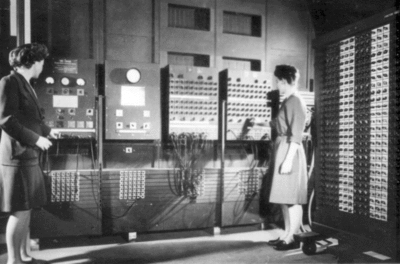1940s

Below title bar: events after World War II: From left to right: The Declaration of the State of Israel in 1948; The Nuremberg Trials were held after the war, in which the prominent members of the political, military, and economic leadership of the defeated Nazi Germany were prosecuted; After the war, the United States carried out the Marshall Plan, which aimed at rebuilding Western Europe; ENIAC, the world's first general-purpose electronic computer.
| Millennium: | 2nd millennium |
| Centuries: | 19th century – 20th century – 21st century |
| Decades: | 1910s 1920s 1930s – 1940s – 1950s 1960s 1970s |
| Years: | 1940 1941 1942 1943 1944 1945 1946 1947 1948 1949 |
| 1940s-related categories: |
Births – Deaths – By country Establishments – Disestablishments |
The 1940s (pronounced "nineteen-forties" and commonly abbreviated as the "Forties") was a decade of the Gregorian calendar that began on January 1, 1940, and ended on December 31, 1949.
Most of World War II took place in the first half of the decade, which had a profound effect on most countries and people in Europe, Asia, and elsewhere. The consequences of the war lingered well into the second half of the decade, with a war-weary Europe divided between the jostling spheres of influence of the Western world and the Soviet Union, leading to the beginning of the Cold War. To some degree internal and external tensions in the post-war era were managed by new institutions, including the United Nations, the welfare state, and the Bretton Woods system, facilitating the post–World War II boom, which lasted well into the 1970s. However, the conditions of the post-war world encouraged decolonialization and emergence of new states and governments, with India, Pakistan, Israel, Vietnam, and others declaring independence, although rarely without bloodshed. The decade also witnessed the early beginnings of new technologies (such as computers, nuclear power, and jet propulsion), often first developed in tandem with the war effort, and later adapted and improved upon in the post-war era.
Politics and wars
Wars

- World War II (1939–1945)
- Nazi Germany invades Poland, Denmark, Norway, Benelux, and the French Third Republic from 1939 to 1941.
- Soviet Union invades Poland, Finland, occupies Latvia, Estonia, Lithuania and Romanian region of Bessarabia from 1939 to 1941.
- Germany faces the United Kingdom in the Battle of Britain (1940). It was the first major campaign to be fought entirely by air forces, and was the largest and most sustained aerial bombing campaign up until that date.
- Germany attacks the Soviet Union (June 22, 1941).
- The United States enter World War II after the attack on Pearl Harbor on December 7, 1941. It would face the Empire of Japan in the Pacific War.
- Germany and Japan suffer defeats at Stalingrad, El Alamein, and Midway in 1942 and 1943.
- Normandy Landings. The forces of the Western Allies land on the beaches of Normandy in Northern France (June 6, 1944).
- Yalta Conference, wartime meeting from 4 February 1945 to 11 February 1945 among the heads of government of the United States, the United Kingdom, and the Soviet Union—President Franklin D. Roosevelt, Prime Minister Winston Churchill, and Premier Joseph Stalin, respectively—for the purpose of discussing Europe's postwar reorganization, intended to discuss the re-establishment of the nations of war-torn Europe.
- The Holocaust, also known as The Shoah (Hebrew: השואה, Latinized ha'shoah; Yiddish: חורבן, Latinized churben or hurban[1]) is the term generally used to describe the genocide of approximately six million European Jews during World War II, a program of systematic state-sponsored extermination by Nazi Germany, under Adolf Hitler, its allies, and collaborators.[2] Some scholars maintain that the definition of the Holocaust should also include the Nazis' systematic murder of millions of people in other groups, including ethnic Poles, the Romani, Soviet civilians, Soviet prisoners of war, people with disabilities, gay men, and political and religious opponents.[3] By this definition, the total number of Holocaust victims is between 11 million and 17 million people.[4]
- The German Instrument of Surrender signed (May 7–8, 1945). Victory in Europe Day.
- Atomic bombings of Hiroshima and Nagasaki (August 6 and August 9, 1945); Surrender of Japan on August 15.
- World War II officially ends on September 2, 1945.

- Indo-Pakistani wars and conflicts
- Arab–Israeli conflict (Early 20th century–present)
- 1948 Arab–Israeli War (1948–1949) – The war was fought between the newly declared State of Israel and its Arab neighbours. The war commenced upon the termination of the British Mandate of Palestine in mid-May 1948. After the Arab rejection of the 1947 United Nations Partition Plan for Palestine (UN General Assembly Resolution 181) that would have created an Arab state and a Jewish state side by side, Egypt, Iraq, Jordan, Lebanon and Syria attacked the state of Israel. In its conclusion, Israel managed to defeat the Arab armies.
Major political changes
- Establishment of the United Nations Charter (June 26, 1945) effective (October 24, 1945).
- Establishment of the defence alliance NATO April 4, 1949.
Internal conflicts
- 1947–1948 Civil War in Mandatory Palestine.
- Victory of Chinese Communist Party led by Mao Zedong in the Chinese Civil War.
- Beginning of Greek Civil War, which extends from 1946 to 1949.
Decolonization and independence

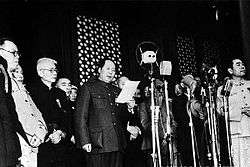
- 1944 – Iceland declares independence from Denmark.
- 1945 – Indonesia declares independence from the Netherlands (effective in 1949 after a bitter armed and diplomatic struggle).
- 1946 – The French Mandate for Syria and the Lebanon dissolves to the independent states of Syria and Lebanon. The French settlers are forced to evacuate the French colony in Syria.
- 1947 – The Partition of the Presidencies and provinces of British India into a secular Union of India and a predominantly Muslim Dominion of Pakistan.
- 1948 – British rule in Burma ends. The State of Israel is established.
- 1949 – The People's Republic of China is officially proclaimed.
Economics
- US Population is 132,122,000c.
- Unemployed in 1940- 8,120,000c.
- National Debt is $43 Billion
- Average Salary $1299
- Average Teacher Salary $1441
- Minimum Wage $.43 per hour
- Annual Inflation averaged 5.5% but ranged as high as 18.1% in 1946[5]
- 55% of US homes have indoor plumbing
- Life expectancy for women is 68.2
- Life expectancy for men is 60.8
- Auto Deaths 34,500c.
Science and technology
Technology
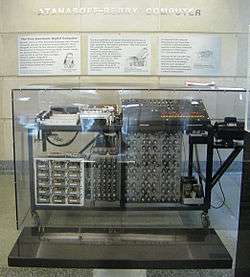
- The Atanasoff-Berry computer is now considered one of the first electronic digital computing device built by John Vincent Atanasoff and Clifford Berry at Iowa State University during 1937–1942.
- Construction in early 1941 of the Heath Robinson Bombe & the Colossus computer, which was used by British codebreakers at Bletchley Park and satellite stations nearby to read Enigma encrypted German messages during World War II. This was operational till 1946 when it was destroyed under orders from Winston Churchill. This is now widely regarded as the first operational computer which in a model rebuild still today has a remarkable computing speed.
- The Z3 as world's first working programmable, fully automatic computing machine was built.
- The first test of technology for an atomic weapon (Trinity test) as part of the Manhattan Project.
- The sound barrier was broken in October, 1947.
- The transistor was invented in December, 1947 at Bell Labs.
- The development of radar.
- The development of ballistic missiles.
- The development of jet aircraft.
- The Jeep.
- The development of commercial television.
- The Slinky.
- The microwave oven.
- The invention of Velcro.
- The invention of Tupperware.
- The invention of the Frisbee
- The invention of hydraulic fracturing
Science
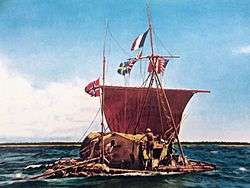
- Physics: the development of quantum theory and nuclear physics.
- Mathematics: the development of game theory and cryptography.
- Thor Heyerdahl's Kon-Tiki crossed the Pacific Ocean proving the practical possibility that people from South America could have settled Polynesia in pre-Columbian times.
- Willard Libby developed radiocarbon dating—a process that revolutionized archaeology.
- The development of modern evolutionary synthesis.
Popular culture
Film

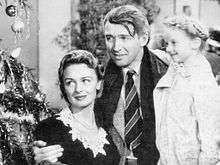
- Oscar winners: Rebecca (1940), How Green Was My Valley (1941), Mrs. Miniver (1942), Casablanca (1943), Going My Way (1944), The Lost Weekend (1945), The Best Years of Our Lives (1946), Gentleman's Agreement (1947), Hamlet (1948), All the King's Men (1949).
- Some of Hollywood's most notable blockbuster films of the 1940s include: The Maltese Falcon directed by John Huston (1941), It's a Wonderful Life directed by Frank Capra (1946), Double Indemnity directed by Billy Wilder (1944), Meet Me in St. Louis directed by Vincente Minnelli (1944), Casablanca directed by Michael Curtiz (1942), Citizen Kane directed by Orson Welles (1941),"The Great Dictator directed by Charlie Chaplin (1940).",The Big Sleep directed by Howard Hawks (1946), The Lady Eve directed by Preston Sturges (1941), The Shop Around the Corner directed by Ernst Lubitsch (1940), White Heat directed by Raoul Walsh (1949), Yankee Doodle Dandy directed by Michael Curtiz (1942), and Notorious directed by Alfred Hitchcock, (1946). The Walt Disney Studios released the animated feature films Pinocchio (1940), Dumbo (1941), Fantasia (1940), and Bambi (1942).
Although the 1940s was a decade dominated by World War II, important and noteworthy films about a wide variety of subjects were made during that era. Hollywood was instrumental in producing dozens of classic films during the 1940s, several of which were about the war and some are on most lists of all-time great films. European cinema survived although obviously curtailed during wartime and yet many films of high quality were made in the United Kingdom, France, Italy, the Soviet Union and elsewhere in Europe. The cinema of Japan also survived. Akira Kurosawa and other directors managed to produce significant films during the 1940s.
Film Noir, a film style that incorporated crime dramas with dark images, became largely prevalent during the decade. Films such as The Maltese Falcon and The Big Sleep are considered classics and helped launch the careers of legendary actors such as Humphrey Bogart and Ava Gardner. The genre has been widely copied since its initial inception.
In France during the war the tour de force Children of Paradise directed by Marcel Carné (1945), was shot in Nazi occupied Paris.[6][7][8] Memorable films from post-war England include David Lean's Great Expectations (1946) and Oliver Twist (1948), Carol Reed's Odd Man Out (1947) and The Third Man (1949), and Powell and Pressburger's A Matter of Life and Death (1946), Black Narcissus (1946) and The Red Shoes (1948), Laurence Olivier's Hamlet, the first non-American film to win the Academy Award for Best Picture and Kind Hearts and Coronets (1949) directed by Robert Hamer. Italian neorealism of the 1940s produced poignant movies made in post-war Italy. Roma, città aperta directed by Roberto Rossellini (1945), Sciuscià directed by Vittorio De Sica (1946), Paisà directed by Roberto Rossellini (1946), La terra trema directed by Luchino Visconti (1948), The Bicycle Thief directed by Vittorio De Sica (1948), and Bitter Rice directed by Giuseppe De Santis (1949), are some well-known examples.
In Japanese cinema, The 47 Ronin is a 1941 black and white two-part Japanese film directed by Kenji Mizoguchi. The Men Who Tread on the Tiger's Tail (1945), and the post-war Drunken Angel (1948), and Stray Dog (1949), directed by Akira Kurosawa are considered important early works leading to his first masterpieces of the 1950s. Drunken Angel (1948), marked the beginning of the successful collaboration between Kurosawa and actor Toshiro Mifune that lasted until 1965.
Music
- The most popular music style during the 1940s was swing, which prevailed during World War II. In the later periods of the 1940s, less swing was prominent and crooners like Frank Sinatra, along with genres such as bebop and the earliest traces of rock and roll, were the prevalent genre.
Literature
- For Whom the Bell Tolls by Ernest Hemingway in 1940.
- The Myth of Sisyphus by Albert Camus in 1942.
- The Stranger by Albert Camus in 1942.
- The Little Prince by Antoine de Saint-Exupéry in 1943.
- Anti-Semite and Jew by Jean-Paul Sartre in 1943.
- The Fountainhead by Ayn Rand in 1943.
- No Exit by Jean-Paul Sartre in 1944.
- Pippi Longstocking by Astrid Lindgren in 1945.
- The Diary of Anne Frank by Anne Frank in 1947.
- Death of a Salesman by Arthur Miller in 1949.
- Nineteen Eighty-Four by George Orwell in 1949.
- The Glass Menagerie by Tennessee Williams in 1944.
Fashion
Even with the challenges imposed by shortages in rayon, nylon, wool, leather, rubber, metal (for snaps, buckles, and embellishments), and even the amount of fabric that could be used in any one garment, the fashion industry's wheels kept chugging slowly along, producing what it could. After the fall of France in 1940, Hollywood drove fashion in the United States almost entirely, with the exception of a few trends coming from war torn London in 1944 and 1945, as America's own rationing hit full force, and the idea of function seemed to overtake fashion, if only for a few short months until the end of the war. Fabrics shifted dramatically as rationing and wartime shortages controlled import items such as silk and furs. Floral prints seem to dominate the early 1940s, with the mid-to-late 1940s also seeing what is sometimes referred to as "atomic prints" or geometric patterns and shapes. The color of fashion seemed to even go to war, with patriotic nautical themes and dark greens and khakis dominating the color palettes, as trousers and wedges slowly replaced the dresses and more traditional heels due to shortages in stockings and gasoline.
People
World leaders
-

Winston Churchill, Franklin D. Roosevelt and Joseph Stalin in the Yalta Conference, February 1945
-

Mao Zedong declares the founding of the modern People's Republic of China, October 1, 1949
-
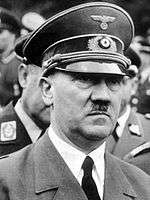
Adolf Hitler during the 1940s
-
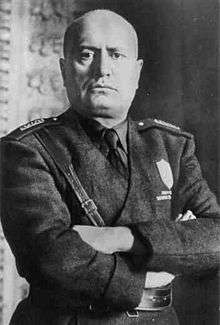
Benito Mussolini, late 1930s
-
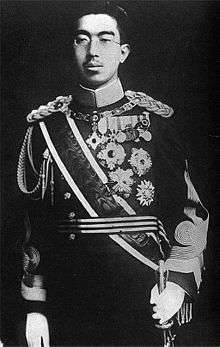
Hirohito, Emperor Shōwa c. late 1930s
-
.svg.png) Chancellor Adolf Hitler
Chancellor Adolf Hitler -
 Prime Minister Ion Victor Antonescu
Prime Minister Ion Victor Antonescu -
.svg.png) Emperor Hirohito
Emperor Hirohito -
_crowned.svg.png) Prime Minister Benito Mussolini
Prime Minister Benito Mussolini -
.svg.png) General Secretary Joseph Stalin
General Secretary Joseph Stalin -
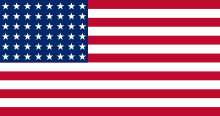 President Franklin D. Roosevelt
President Franklin D. Roosevelt -
 President Harry S. Truman
President Harry S. Truman -
 Prime Minister Winston Churchill
Prime Minister Winston Churchill -
 Prime Minister Clement Attlee
Prime Minister Clement Attlee -
 Leader of the Free French Charles de Gaulle
Leader of the Free French Charles de Gaulle -
 Chief of State Philippe Pétain
Chief of State Philippe Pétain -
 President Albert Lebrun
President Albert Lebrun -
 President Federico Laredo Brú, until late 1940
President Federico Laredo Brú, until late 1940 -
 President Fulgencio Batista
President Fulgencio Batista -
 President Ramón Grau
President Ramón Grau -
 President Carlos Prío Socarrás
President Carlos Prío Socarrás -
 Prime Minister Robert Menzies
Prime Minister Robert Menzies -
 Prime Minister Arthur Fadden
Prime Minister Arthur Fadden -
 Prime Minister John Curtin
Prime Minister John Curtin -
 Prime Minister Frank Forde
Prime Minister Frank Forde -
 Prime Minister Ben Chifley
Prime Minister Ben Chifley -
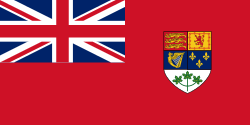 Prime Minister William Lyon Mackenzie King
Prime Minister William Lyon Mackenzie King -
 Governor-General Muhammad Ali Jinnah
Governor-General Muhammad Ali Jinnah -
 Prime Minister Liaquat Ali Khan
Prime Minister Liaquat Ali Khan -
 Chairman Mao Zedong(毛泽东)
Chairman Mao Zedong(毛泽东) -
 Chairman Chiang Kai-shek
Chairman Chiang Kai-shek -
.svg.png) Reza Shah Pahlavi, until 1941
Reza Shah Pahlavi, until 1941 -
.svg.png) Shah Mohammad Reza Pahlavi
Shah Mohammad Reza Pahlavi -
 Prime Minister and President Hồ Chí Minh
Prime Minister and President Hồ Chí Minh -
 Prime Minister David Ben-Gurion
Prime Minister David Ben-Gurion -
.svg.png) Head of state Francisco Franco
Head of state Francisco Franco -
 President İsmet İnönü
President İsmet İnönü -
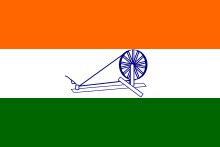 Prime-Minister Pandit Jawaharlal Nehru
Prime-Minister Pandit Jawaharlal Nehru -
 President Juan Perón
President Juan Perón -
 Politician Jorge Eliecer Gaitán
Politician Jorge Eliecer Gaitán -
 President Eduardo Santos
President Eduardo Santos -
 President Darío Echandía Olaya
President Darío Echandía Olaya -
 President Alberto Lleras Camargo
President Alberto Lleras Camargo -
 President Mariano Ospina Pérez
President Mariano Ospina Pérez -
.svg.png) General Aung San
General Aung San -
.svg.png) President Getúlio Vargas
President Getúlio Vargas -
.svg.png) President Romulo Betancourt
President Romulo Betancourt -
 Queen Wilhelmina of the Netherlands
Queen Wilhelmina of the Netherlands
Military leaders
-

General Eisenhower speaks with troops prior to D-Day
-

Isoroku Yamamoto, Japanese Imperial Navy Fleet Admiral responsible for attack on Pearl Harbor.
-
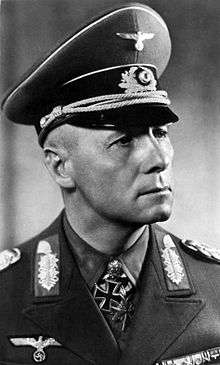
Erwin Rommel, German Field Marshal who led the North African Campaign.
-

The Supreme Commanders on 5 June 1945 in Berlin: Bernard Montgomery, Dwight D. Eisenhower, Georgy Zhukov and Jean de Lattre de Tassigny.
-
.svg.png) Field Marshal Erwin Rommel
Field Marshal Erwin Rommel -
.svg.png) Reichsmarschall Hermann Göring
Reichsmarschall Hermann Göring -
.svg.png) Field Marshal Erich von Manstein
Field Marshal Erich von Manstein -
.svg.png) Field Marshal Gerd von Rundstedt
Field Marshal Gerd von Rundstedt -
 Marshal Ion Victor Antonescu
Marshal Ion Victor Antonescu -
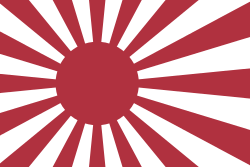 General Hideki Tōjō
General Hideki Tōjō -
 General Kuniaki Koiso
General Kuniaki Koiso -
 Field Marshal Hajime Sugiyama
Field Marshal Hajime Sugiyama -
 Fleet Admiral Isoroku Yamamoto
Fleet Admiral Isoroku Yamamoto -
 Fleet Admiral Osami Nagano
Fleet Admiral Osami Nagano -
 Field Marshal Georgy Zhukov
Field Marshal Georgy Zhukov -
 Field Marshal Ivan Konev
Field Marshal Ivan Konev -
 General Dwight D. Eisenhower
General Dwight D. Eisenhower -
 General George Marshall
General George Marshall -
 General Douglas MacArthur
General Douglas MacArthur -
 General Omar Bradley
General Omar Bradley -
 General George S. Patton
General George S. Patton -
 Fleet Admiral Chester W. Nimitz
Fleet Admiral Chester W. Nimitz -
 Fleet Admiral Ernest J. King
Fleet Admiral Ernest J. King -
 Field Marshal Harold Alexander
Field Marshal Harold Alexander -
 Field Marshal Bernard Montgomery
Field Marshal Bernard Montgomery -
 Général d'Armée Jean de Lattre de Tassigny
Général d'Armée Jean de Lattre de Tassigny -
 Brigadier general Charles de Gaulle
Brigadier general Charles de Gaulle -
 General Henri Winkelman
General Henri Winkelman
Activists and religious leaders
-
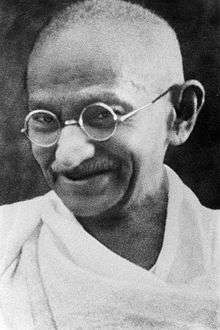
Mohandas Gandhi during the 1940s
-

Raoul Wallenberg, c. 1944
-

Muhammed Ali Jinnah with Gandhi, 1944.
-
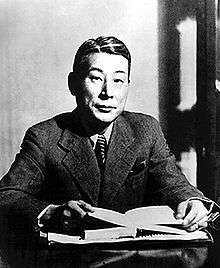
Chiune Sugihara c.1940s
- Joel Brand
- Behic Erkin
- Varian Fry
- Mohandas Gandhi
- Billy Graham
- Yitzhak HaLevi Herzog
- Muhammad Ali Jinnah
- Necdet Kent
- Aristides de Sousa Mendes
- Pope Pius XII
- Martha Sharp
- Waitstill Sharp
- Chiune Sugihara
- Raoul Wallenberg
Politics
- Abdel Rahman Azzam Pasha, Secretary-general Arab League
- Georgi Mikhailov Dimitrov, Chairman of the Executive Committee Communist International
- Camille Gutt, Managing Director International Monetary Fund
- Jacques Camille Paris, Secretary-general Council of Europe
- Edward Warner, President of the Council International Civil Aviation Organization
- John G. Winant, Director International Labour Organization
Entertainers
-
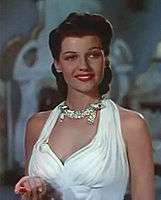
Rita Hayworth as Doña Sol des Muire in Blood and Sand (1941)
-

Betty Grable, famous pin-up girl, (1943).
-
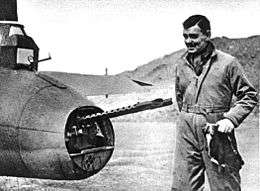
Clark Gable with an 8th AF Boeing B-17 Flying Fortress in Britain, (1943).
Musicians
-
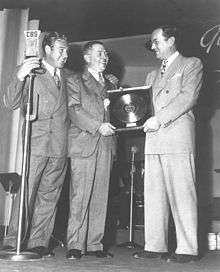
Gold record for Chattanooga Choo Choo presented to Glenn Miller (right), by W. Wallace Early of RCA Victor with announcer Paul Douglas on the left, February, 1942. In December 1944 Glenn Miller perished on a flight from London to Paris when his plane disappeared over the English Channel.
-

Benny Goodman performing in 1943 Stage Door Canteen
-

Frank Sinatra performing Ol' Man River in 1946's Till the Clouds Roll By
-

Perry Como as Nicky Ricci performing "Here Comes Heaven Again" in 1946 Doll Face
- Marian Anderson
- Louis Armstrong
- Eddy Arnold
- Gene Autry
- Pearl Bailey
- Benny Carter
- Ray Charles
- Charlie Barnet
- Count Basie
- Irving Berlin
- Al Bowlly
- Les Brown
- Erskine Butterfield
- Sammy Cahn
- Cab Calloway
- Nat King Cole
- Perry Como
- Bing Crosby
- Bob Crosby
- Miles Davis
- Willie Dixon
- Jimmy Dorsey
- Tommy Dorsey
- K. C. Douglas
- Champion Jack Dupree
- Billy Eckstine
- Duke Ellington
- H-Bomb Ferguson
- Ella Fitzgerald
- Ira Gershwin
- Dizzy Gillespie
- Benny Goodman
- Stéphane Grappelli
- Homer Harris
- Screamin' Jay Hawkins
- Richard Hayman
- Dick Haymes
- Earl Hines
- Billie Holiday
- John Lee Hooker
- Lena Horne
- Betty Hutton
- Sir Lancelot
- Big Joe Turner
- Bull Moose Jackson
- Mahalia Jackson
- Harry James
- Louis Jordan
- Blind Willie Johnson
- Al Jolson
- Kitty Kallen
- Danny Kaye
- Sammy Kaye
- Stan Kenton
- B.B. King
- Evelyn Knight
- Gene Krupa
- Frankie Laine
- Mario Lanza
- Peggy Lee
- Dean Martin
- Grady Martin
- Johnny Mercer
- Amos Milburn
- Glenn Miller
- Roy Milton
- Charles Mingus
- Thelonious Monk
- Vaughn Monroe
- Benny Moré
- Ray Noble
- Charlie Parker
- Les Paul
- Édith Piaf
- Cole Porter
- Bud Powell
- Louis Prima
- Django Reinhardt
- Pete Johnson
- Max Roach
- Marty Robbins
- Paul Robeson
- Richard Rodgers
- Artie Shaw
- Dinah Shore
- Frank Sinatra
- Memphis Slim
- Kate Smith
- Billy Strayhorn
- Maxine Sullivan
- Art Tatum
- Martha Tilton
- Ernest Tubb
- Sarah Vaughan
- T-Bone Walker
- Little Walter
- Muddy Waters
- Margaret Whiting
- Cootie Williams
- Hank Williams
- Tex Williams
- Bob Wills
- Teddy Wilson
Bands
- The Andrew Sisters
- The Boswell Sisters
- The Ink Spots
- The Merry Macs
- The Mills Brothers
- The Pied Pipers
- The Ravens
- The Robins
- Sons of The Pioneers
Sports
During the 1940s Sporting events were disrupted and changed by the events that engaged and shaped the entire world. The 1940 and 1944 Olympic Games were cancelled because of World War II. During World War II in the United States Heavyweight Boxing Champion Joe Louis and numerous stars and performers from American baseball and other sports served in the armed forces until the end of the war. Among the many baseball players (including well known stars) who served during World War II were Moe Berg, Joe DiMaggio, Bob Feller, Hank Greenberg, Stan Musial (in 1945), Warren Spahn, and Ted Williams. They like many others sacrificed their personal and valuable career time for the benefit and well being of the rest of society. The Summer Olympics were resumed in 1948 in London and the Winter games were held that year in St. Moritz, Switzerland.
Baseball

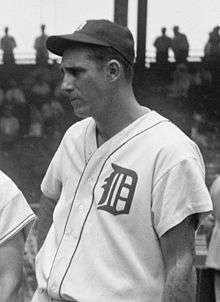
During the early 1940s World War II had an enormous impact on Major League Baseball as many players including many of the most successful stars joined the war effort. After the war many players returned to their teams, while the major event of the second half of the 1940s was the 1945 signing of Jackie Robinson to a players contract by Branch Rickey the general manager of the Brooklyn Dodgers. Signing Robinson opened the door to the integration of Major League Baseball finally putting an end to the professional discrimination that had characterized the sport since the 19th century.
- Joe DiMaggio
- Bill Dickey
- Bob Feller
- Josh Gibson
- Hank Greenberg
- Monte Irvin
- Buck Leonard
- Johnny Mize
- Stan Musial
- Satchel Paige
- Branch Rickey
- Jackie Robinson
- Ted Williams
Boxing
During the mid-1930s and throughout the years leading up to the 1940s Joe Louis was an enormously popular Heavyweight boxer. In 1936 he lost an important 12 round fight (his first loss) to the German boxer Max Schmeling and he vowed to meet Schmeling once again in the ring. Louis' comeback bout against Schmeling became an international symbol of the struggle between the USA and democracy against Nazism and Fascism. When on June 22, 1938, Louis knocked Schmeling out in the first few seconds of the first round during their rematch at Yankee Stadium, his sensational comeback victory riveted the entire nation. Louis enlisted in the U.S. Army on January 10, 1942, in response to the Japanese attack on Pearl Harbor. Louis' cultural impact was felt well outside the ring. He is widely regarded as the first African American to achieve the status of a nationwide hero within the United States, and was also a focal point of anti-Nazi sentiment leading up to and during World War II.[10]
- Buddy Baer
- Ezzard Charles
- Billy Conn
- Rocky Graziano
- Joe Louis
- Sugar Ray Robinson
- Max Schmeling
- Jersey Joe Walcott
- Tony Zale
See also
Timeline
The following articles contain brief timelines listing the most prominent events of the decade.
1940 • 1941 • 1942 • 1943 • 1944 • 1945 • 1946 • 1947 • 1948 • 1949
References
- ↑ "Holocaust," Encyclopædia Britannica, 2009: "the systematic state-sponsored killing of six million Jewish men, women, and children and millions of others by Nazi Germany and its collaborators during World War II. The Germans called this "the final solution to the Jewish question ..."
- ↑ Niewyk, Donald L. The Columbia Guide to the Holocaust, Columbia University Press, 2000, p. 45: "The Holocaust is commonly defined as the murder of more than 5,000,000 Jews by the Germans in World War II." Also see "The Holocaust", Encyclopædia Britannica, 2007: "the systematic state-sponsored killing of six million Jewish men, women and children, and millions of others, by Nazi Germany and its collaborators during World War II. The Germans called this "the final solution to the Jewish question".
- ↑ Niewyk, Donald L. and Nicosia, Francis R. The Columbia Guide to the Holocaust, Columbia University Press, 2000, pp. 45–52.
- ↑ Donald Niewyk suggests that the broadest definition, including Soviet civilian deaths, would produce a death toll of 17 million. Estimates of the death toll of non-Jewish victims vary by millions, partly because the boundary between death by persecution and death by starvation and other means in a context of total war is unclear. Overall, about 5.7 million (78 percent) of the 7.3 million Jews in occupied Europe perished (Gilbert, Martin. Atlas of the Holocaust 1988, pp. 242–244). Compared to five to 11 million (1.4 percent to 3.0 percent) of the 360 million non-Jews in German-dominated Europe. Small, Melvin and J. David Singer. Resort to Arms: International and civil Wars 1816–1980 and Berenbaum, Michael. A Mosaic of Victims: Non-Jews Persecuted and Murdered by the Nazis. New York: New York University Press, 1990
- ↑ "Inflation and CPI Consumer Price Index 1940-1949". InflationData. Retrieved 23 April 2014.
- ↑ DeWitt Bodeen, Les Enfants du Paradis, filmreference.com
- ↑ Gio MacDonald, Edinburgh University Film Society program notes, 1994–95
- ↑ Quoted by Roger Ebert, Children of Paradise, Chicago Sun-Times, 6 January 2002 review oif the Criterion DVD release
- ↑ http://www.womeninwwii.com/fashion/1940sfashion.asp
- ↑ Bloom, John; Willard, Michael Nevin (2002). John Bloom and Michael Nevin Willard, eds. Sports Matters: Race, Recreation, and Culture. New York: New York University Press. pp. 46–47. ISBN 978-0-8147-9882-9.
Further reading
- Lingeman, Richard. The Noir Forties: The American People from Victory to Cold War (New York: Nation Books, 2012. xii, 420 pp.)
- Yust, Walter, ed., 10 Eventful Years (4 vol., Chicago: Encyclopædia Britannica Inc, 1947), encyclopedia of world events 1937-46
External links
| Wikimedia Commons has media related to 1940s. |
- Heroes of the 1940s - slideshow by Life magazine
- 1940s.org
